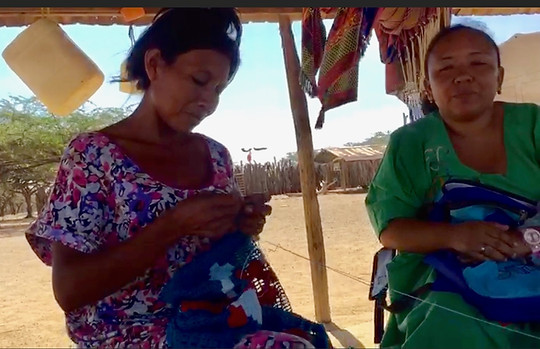Who We Are



Culture
Wayuu indigenous people live in northern Venezuela and Colombia on their ancestral homeland, the Guajira Peninsula.
The Wayuu story is one of resistance. In spite of ongoing contact and pressure from alijuna (non-Wayuu) society for the last 500 years, they have maintained their language, matrilineal descent system and cultural traditions, including livestock herding, a rich weaving tradition, mortuary and coming of age ceremonies, and shamanistic practices.



Our Artisans
We consider it a privilege to provide an avenue for people in the United States to acquire these extraordinary Wayuu textiles.
Since we began this process, we have met many talented and inspiring artists and created deep connections. It is also satisfying to know that US dollars go a long way for weavers and their families. In the short time that they have been selling hammocks and bags to US buyers at the prices they decided were fair, artisans have improved their living conditions and children's futures. Moving from a corrugated metal house with a dirt floor to a roomy cinder block house and paying for college tuition for children were made possible by income from Artesanías Walapüin.


Yaleidis del Carmen Cambar Mengual
I am Wayuu Ginnu (fox clan) born and raised on Karaquita ranch in the Departament of the Guajira on September 18 1978. My parents are María del Rosario Mengual Ginnu and José Domingo Cambar of the Uliana clan. I am the eldest of my siblings and I studied at the Aremasain Indigenous Boarding School.
I completed secondary school in Venezuela and earned Bachelor's degrees in humanities and library sciences from the University of Zulia (Maracaibo-Venezuela). Years later I earned a Bachelor’s in Primary Education and with a specialization in bilingual Intercultural Education.
My life partner Franklyn and I have three daughters, April, Franleidis, and Isamar and currently live with my family on Karaquita ranch where I was born.


Edita Epieyu Wayuu Ginnu
I started learning to weave at the early age of 7. Early each morning, I would sit beside my dear grandmother (mamachon toushicut) to watch her make woven bags (susu). She used to weave large bags (kattoui ) out of natural fibers with an old style needle crafted out of animal bone. Back then, kattoui were used to carry large water jars (mukuras) that were made of clay. I craved this knowledge and skill because I understood that it is an important education a girl receives from her maternal family members.
Over the years, I've been perfecting the art form. During my puberty confinement as a young woman (majayut), I learned much more. During that time, my female relatives explained that we women are the pillars of our clan and bare the responsibility to transmit our ancestral weaving legacy to future generations. Today, I take great pride in passing it on to my daughter and nieces.
Yaquelin Cecilia Cambar Mengual Ginnu
Yaqui currently works as an artisan and runs the Walapüin collective. She was born in Colombia in the department of La Guajira in the ranchería of Karaquita on November 2, 1980. She is the third child of five sisters born to María del Rosario Mengual Ginnu and José Domingo Cambar Uliana.
Her childhood was a happy one in her family’s ranchería where she was born. Together with her sisters, she attended primary school in the rancheria, after which she ended up finishing primary school at the San José Indigenous Boarding School in Uribia, Colombia, Here she earned her high school diploma in social promotion with a specialization in Wayuu community development. While she learned a lot in boarding school, above all she learned to love her culture and the art of Wayuu weaving.
Yaqui has also worked as a health promoter for the Palatine Foundation and for a government organization as a social worker advocating on behalf of Wayuu communities. She and her life partner, Luis Manuel Orozco de la Barrera, have three beautiful sons, Yerel, Luis and Eliud.

Alicia Jarariyu
Alicia (pictured on the left) is 33 years old and was born on Pasipamana or Karaquita Ranch on the Colombian Guajira Peninsula. She is one of of the artists who creates the decorative fringe (flecos) for the hammocks.
Her mother passed on this art form to her when she was 10 years old. Though she admits she wasn’t that excited to learn to weave at that young age, she grew to love it. At the age of thirteen she and her sister Maria Teresa started to design and create flecos. Today she is very happy to be a weaver and she plans to pass on the art form to her daughters so it isn’t lost. She looks forward to teaching them to weave hammocks, bags, and flecos to continue this tradition.

Mariana López Uliana
I am an artisan and I weave hammocks and shoulder bags. I was born on June 2, 1987 in the Triachon ranchería where I spent my childhood and adolescence. When I married Joel Pana of the Ginnu clan, I moved to the ranchería of my mother-in-law Maria del Rosario Ginnu. Joel and I have four children.
Mariana tells her story here...
